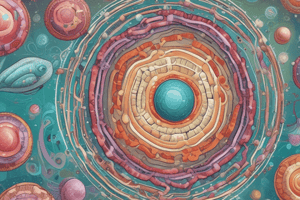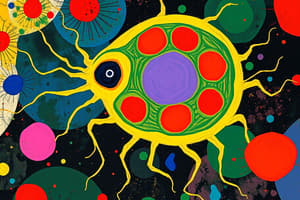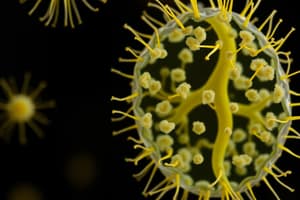Podcast
Questions and Answers
Which characteristic is unique to protozoans that distinguishes them from algae and fungus-like protists?
Which characteristic is unique to protozoans that distinguishes them from algae and fungus-like protists?
- Photosynthetic capability
- Unicellular structure
- Nonphotosynthetic nature (correct)
- Motility via flagella or cilia
A protozoan is observed ingesting a whole bacterium through a specialized structure. Which feeding mechanism and structure are most likely being used?
A protozoan is observed ingesting a whole bacterium through a specialized structure. Which feeding mechanism and structure are most likely being used?
- Holozoic feeding through a cytoproct
- Saprozoic feeding through a cytoproct
- Holozoic feeding through a cytostome (correct)
- Saprozoic feeding through a cytostome
In schizogony, what is the correct sequence of events and the name of the cells produced?
In schizogony, what is the correct sequence of events and the name of the cells produced?
- Nucleus divides multiple times, cell divides into many cells, producing merozoites (correct)
- Cell divides into two, each with identical nuclei, producing schizonts
- Cell divides multiple times, nucleus divides once, producing merozoites
- Nucleus and cell divide simultaneously, producing schizonts
How does conjugation in protists differ fundamentally from conjugation in bacteria?
How does conjugation in protists differ fundamentally from conjugation in bacteria?
A protist is found to have a rigid protein layer inside the plasma membrane. What is the function of this structure?
A protist is found to have a rigid protein layer inside the plasma membrane. What is the function of this structure?
Why is the term 'protist' not considered a formal taxonomic term?
Why is the term 'protist' not considered a formal taxonomic term?
Which characteristic is used to classify protists into different taxonomic groups within the domain Eukarya?
Which characteristic is used to classify protists into different taxonomic groups within the domain Eukarya?
In which supergroup would you classify a parasitic protozoan that moves using pseudopodia?
In which supergroup would you classify a parasitic protozoan that moves using pseudopodia?
Entamoeba histolytica is transmitted via cysts in feces and is the primary cause of amoebic dysentery. In which supergroup is it classified?
Entamoeba histolytica is transmitted via cysts in feces and is the primary cause of amoebic dysentery. In which supergroup is it classified?
What is the primary difference between cellular and plasmodial slime molds regarding their cellular structure?
What is the primary difference between cellular and plasmodial slime molds regarding their cellular structure?
What is the function of the apical complex in apicomplexans?
What is the function of the apical complex in apicomplexans?
How do ciliates reproduce sexually?
How do ciliates reproduce sexually?
Which of the following characteristics distinguishes oomycetes from fungi?
Which of the following characteristics distinguishes oomycetes from fungi?
Giardia lamblia possesses which distinctive characteristic?
Giardia lamblia possesses which distinctive characteristic?
What is the primary mode of transmission for Trichomonas vaginalis?
What is the primary mode of transmission for Trichomonas vaginalis?
Which structure is responsible for giving Euglena its distinctive shape?
Which structure is responsible for giving Euglena its distinctive shape?
Trypanosoma brucei colonizes which parts of the body after being transmitted by the tsetse fly?
Trypanosoma brucei colonizes which parts of the body after being transmitted by the tsetse fly?
Which disease is caused by trypanosomes of the genus Leishmania?
Which disease is caused by trypanosomes of the genus Leishmania?
Which activity poses a risk of transmitting Toxoplasma gondii infection to pregnant individuals?
Which activity poses a risk of transmitting Toxoplasma gondii infection to pregnant individuals?
Which factor is NOT considered by the CDC when prioritizing neglected parasitic infections (NPIs)?
Which factor is NOT considered by the CDC when prioritizing neglected parasitic infections (NPIs)?
Flashcards
Protist
Protist
Informal term for diverse microscopic eukaryotic organisms without a shared evolutionary origin.
Trophozoites
Trophozoites
Free-living or parasitic protozoa in a feeding and growth stage, consuming small particulate food.
Encystment
Encystment
The process by which a trophozoite transforms into a cyst.
Cyst
Cyst
Signup and view all the flashcards
Excystment
Excystment
Signup and view all the flashcards
Schizogony
Schizogony
Signup and view all the flashcards
Merozoites
Merozoites
Signup and view all the flashcards
Schizonts
Schizonts
Signup and view all the flashcards
Conjugation (Protists)
Conjugation (Protists)
Signup and view all the flashcards
Ectoplasm
Ectoplasm
Signup and view all the flashcards
Endoplasm
Endoplasm
Signup and view all the flashcards
Cytostome
Cytostome
Signup and view all the flashcards
Contractile vacuoles
Contractile vacuoles
Signup and view all the flashcards
Amoebozoa
Amoebozoa
Signup and view all the flashcards
Chromalveolata
Chromalveolata
Signup and view all the flashcards
Apicomplexans
Apicomplexans
Signup and view all the flashcards
Ciliates
Ciliates
Signup and view all the flashcards
Excavata
Excavata
Signup and view all the flashcards
Giardia lamblia
Giardia lamblia
Signup and view all the flashcards
Trypanosomes
Trypanosomes
Signup and view all the flashcards
Study Notes
- Eukaryotic microbes have diverse life cycles, morphologies, and nutritional needs.
- Protists, parasitic worms, and fungi are eukaryotic microbes that cause disease
Clinical Focus Part 1
- Sarah, a 7-year-old, was diagnosed with ringworm after a red, itchy spot on her arm was examined with a Wood's lamp, which caused the spot to fluoresce.
- Ringworm presents as a raised ring, gray or brown on darker skin, and red on lighter skin.
Characteristics of Protists
- Protist is an informal term for diverse microscopic eukaryotic organisms without shared evolutionary origin.
- Historically, protists were grouped into "animal-like" protozoans, "plant-like" algae, and "fungus-like" protists.
- Plankton are microorganisms that drift in water, including motile, nonphotosynthetic zooplankton and photosynthetic phytoplankton.
- Protozoans inhabit aquatic and terrestrial habitats; some are free-living, parasitic, or beneficial symbionts.
- Trophozoites are the feeding and growth form of protozoa and feed on small particulate food sources.
- Some protozoa can develop into an encapsulated cyst stage under harsh conditions and revert to trophozoites when conditions are favorable.
- Encystment is the process by which a trophozoite becomes a cyst.
- Excystment is when cysts are triggered by environmental cues to become active again.
- Eimeria is a protozoan genus capable of encystment and includes human and animal pathogens and oocysts are shed in feces.
- Protozoans reproduce asexually (binary fission, budding, or schizogony) or sexually.
- Schizogony involves multiple nuclear divisions before the cell divides into smaller cells called merozoites, stored in schizonts.
- Sexual reproduction in protozoans includes syngamy (fusion of haploid gametes) or conjugation (exchange of DNA).
- Protist conjugation is a form of eukaryotic sexual reproduction between cells of different mating types found in ciliates
- The plasma membrane (plasmalemma) is a feature of all protozoans.
- Pellicle is a rigid protein band inside the membrane of some protozoans.
- Ectoplasm is the outer gel layer of cytoplasm, whereas endoplasm is the inner fluid region of cytoplasm.
- A cytostome is a specialized structure for phagocytosis and a cytoproct is used for exocytosis of wastes.
- Oral grooves lined with cilia sweep food particles into cytostomes.
- Protozoans are heterotrophic, ingesting whole food particles (holozoic) or soluble food molecules (saprozoic).
- Flagella or cilia made of microtubules are used for locomotion; cytoplasmic extensions (pseudopodia) are also used for movement.
- Contractile vacuoles are organelles used for osmotic regulation.
- Mitochondria may be absent, altered to kinetoplastids, or hydrogenosomes
Taxonomy of Protists
- Protists are a polyphyletic group scattered across different taxonomic groups within Eukarya.
- Eukarya is divided into six supergroups: Amoebozoa, Excavata, Chromalveolata, Opisthokonta, Rhizaria, and Archaeplastida.
- Amoebozoa, Excavata, and Chromalveolata contain many protozoans of clinical significance.
Amoebozoa
- Amoebozoa includes protozoans that use amoeboid movement via pseudopodia formed by actin microfilaments.
- Entamoeba includes commensal or parasitic species, such as E. histolytica, which causes amoebic dysentery.
- Acanthamoeba can cause keratitis and blindness.
- Naegleria fowleri is a "brain eating amoeba" classified in the phylum Percolozoa.
- Eumycetozoa (slime molds) include cellular and plasmodial slime molds.
- Cellular slime molds exist as individual amoeboid cells that aggregate into a mobile slug, forming a fruiting body with haploid spores.
- Plasmodial slime molds exist as large, multinucleate amoeboid cells that form reproductive stalks to produce spores that divide into gametes.
- Dictyostelium discoideum is a cellular slime mold used to study cell differentiation, with single-celled and multicelled life stages.
Chromalveolata
- Chromalveolata is a supergroup including apicomplexans, ciliates, diatoms, and dinoflagellates, united by similar origins of plastids.
- Apicomplexans are intra- or extracellular parasites with an apical complex for entering host cells.
- They have complex life cycles with an infective sporozoite that undergoes schizogony to produce merozoites
- The genus Plasmodium is an example.
- Cryptosporidium parvum causes intestinal symptoms and epidemic diarrhea when cysts contaminate drinking water.
- Theileria (Babesia) microti, transmitted by Ixodes scapularis, causes recurring fever and is a common transfusion-transmitted pathogen.
- Toxoplasma gondii causes toxoplasmosis, transmitted from cat feces, unwashed produce, or undercooked meat, and can cause birth defects.
- Ciliates (Ciliaphora) are a diverse group with cilia on their cell surface for locomotion or feeding.
- Balantidium coli is a parasitic ciliate that affects humans, causing intestinal illness.
- Paramecium is a motile ciliate with a visible cytostome and cytoproct.
- Stentor is a sessile ciliate that uses cilia for feeding.
- Ciliates have a diploid, somatic micronucleus (for sexual reproduction) and a polyploid macronucleus derived from the micronucleus (for metabolic genes).
- Ciliates reproduce through conjugation, exchanging micronuclei to form a genetically different diploid micronucleus.
- Öomycetes (water molds) have similarities to fungi but have cellulose cell walls and are generally diploid.
- Phytophthora is a plant pathogen that caused the Irish potato famine.
Excavata
- Excavata includes primitive eukaryotes and parasites with limited metabolic abilities.
- These organisms have complex cell shapes, often including a depression on the cell surface called an excavate
- Fornicata lack mitochondria but have flagella, including Giardia lamblia, which causes diarrheal illness.
- Parabasalia are animal endosymbionts with basal bodies, modified mitochondria (kinetoplastids), undulating membranes, and many flagella.
- Trichomonads include Trichomonas vaginalis, which causes the sexually transmitted disease trichomoniasis.
- Euglenozoa include photosynthetic and nonphotosynthetic species with two flagella, a pellicle, a stigma (eyespot), and chloroplasts.
- Euglena is typically not pathogenic.
- Trypanosomes (Trypanosoma) are parasitic pathogens.
- T. brucei causes African trypanosomiasis (African sleeping sickness), transmitted by the tsetse fly (Glossina spp.).
- T. cruzi causes American trypanosomiasis (Chagas disease), transmitted by Triatoma spp. ("kissing bugs").
- Leishmania includes trypanosomes that cause disfiguring skin disease and sometimes systemic illness
Eye on Ethics: Neglected Parasites
- The CDC has identified five neglected parasitic infections (NPIs): toxoplasmosis, Chagas disease, toxocariasis, cysticercosis, and trichomoniasis.
- These NPIs are prioritized due to the number of people infected, the severity of the illness, and whether the illness can be treated or prevented.
Studying That Suits You
Use AI to generate personalized quizzes and flashcards to suit your learning preferences.




